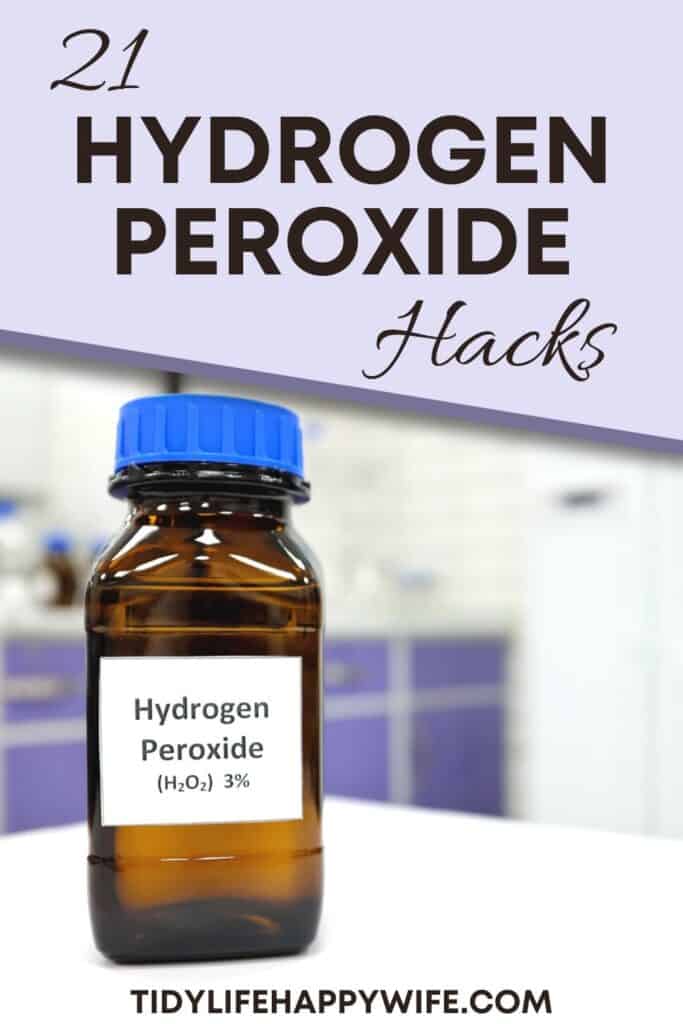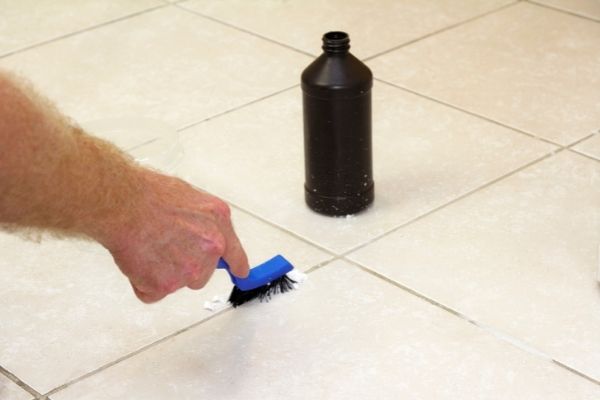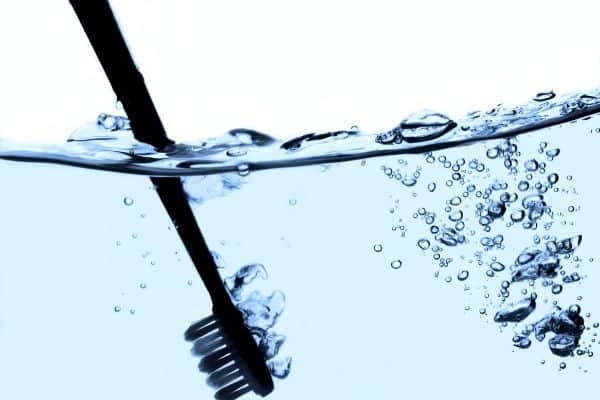21 Brilliant Hydrogen Peroxide Hacks You Need in Your Life
Do you prefer natural health and beauty products? Are you looking for a disinfecting solution to kill harmful bacteria and viruses while cleaning your home? Check out these brilliant hydrogen peroxide hacks and cleaning uses.
When you think of hydrogen peroxide, you probably remember lightening your hair or cleaning out a nasty cut before covering it with a band-aid.
Personally, I remember spraying half a bottle of Sun-In (which was mostly peroxide) on my hair and moving my lawn chair around the yard so the sun was directly on my head all day (Yes, I’m was an 80’s teen)!
There are much better hair products on the market these days, and hydrogen peroxide is no longer recommended for wound care. Turns out some studies have shown that it actually damages the soft tissue and slows the healing process1.
All of that aside, there are still a ton of useful hydrogen peroxide hacks that make it one of the most useful products in many homes today.

This post may contain affiliate links. Please see my disclosure policy for details.
First, A Little History
Hydrogen peroxide has been around since the early 1800s. It’s a clear liquid compound that consists of a combination of two hydrogens and two oxygen molecules.
Hydrogen peroxide becomes unstable and turns into separate water and oxygen molecules when exposed to light for too long.
The unmistakable brown bottle protects the hydrogen peroxide from the light. It also makes it very easy to identify on store shelves.
Hydrogen peroxide can usually be found in drug, department, and grocery stores nationwide. It can also be purchased on Amazon and other online shopping sites.
The concentration you’ll find in those stores is typically a 3% mix of hydrogen peroxide with 97% water and is intended for household use.
What is hydrogen peroxide used for?
Hydrogen peroxide is a powerful disinfectant that’s perfect for cleaning and disinfecting household surfaces. It’s also an oxidizer (bleaching agent) and mild antiseptic which makes it great for all kinds of health and beauty uses including lightening and whitening your teeth, hair, and your laundry.
Hydrogen Peroxide Hacks
1. Clean and Disinfect a Kitchen Sink
Kitchen sinks are a hotbed for bacteria and should be sanitized daily. Spray sink surfaces with hydrogen peroxide and let sit for 10 minutes. Scrub and rinse clean. No more bacteria.
You can also mix equal parts of hydrogen peroxide and rubbing alcohol for a spray-on, leave on disinfectant. Just make sure to rinse the sink before using it for any food preparation.
2. Disinfect the Toilet
I’ve been talking a lot about bacteria, so I’m sure you saw this one coming. The toilet is one of the places I constantly use hydrogen peroxide, especially when I’m deep cleaning the bathroom.
I spray down all exterior and interior surfaces of the toilet, then I pour half a cup in the tank and half a cup in the bowl right before we leave the house.
Mine ends up sitting for several hours before I scrub, but I think 30 minutes should be sufficient. Scrub the interior of the tank and toilet bowl, wipe down the exterior and dry.

3. Clean the Garbage Can
Your kitchen garbage can is constantly exposed to all kinds of raw and cooked food waste.
It’s no wonder it’s one of the germiest, most bacteria-ridden places in your home. Here’s one of the best hydrogen peroxide hacks I know of to get rid of bacteria.
Spray the entire interior and exterior of the garbage can with hydrogen peroxide and let it sit for 15 minutes. Rinse, dry, and replace the trash bag.
4. Keep the Shower Clean
Mix ½ cup hydrogen peroxide, ½ cup rubbing alcohol in an opaque spray bottle.
Mix gently and spray down shower walls after the last shower each day.
Some people will tell you to add dishwashing detergent to the mixture. Since this is a leave-on spray, I’ve never done that.
You’re supposed to leave this mixture on once you spray it, and I don’t know about you, but I already have enough trouble keeping up with soap residue and buildup in the shower.
5. Whiten Grout
Clean the grout to remove surface dirt, then spray liberally with undiluted hydrogen peroxide and let sit for 30 minutes. Scrub with a grout brush, wipe clean and let dry. Repeat as necessary.
If you need a little extra scrubbing power, you can add baking soda, but you’ll need to rinse well to remove all of the residues.

6. Remove Mold and Mildew
Too much moisture in your home can cause a buildup of mold and mildew which is difficult to clean.
Completely wet the moldy or mildewy area with undiluted hydrogen peroxide. Let sit for 15 to 30 minutes, then scrub and wipe clean.
Caution – if you have or suspect you have toxic black mold, please call a professional for removal
7. Clean Mirrors & Glass
Mix equal parts hydrogen peroxide and water in an opaque spray bottle. Spray mirror or glass, and buff dry with a clean microfiber cloth.
Now your mirror is clean and streak-free.
8. Remove Baked-On Gunk from Bakeware
For stainless steel bakeware, mix 1 part hydrogen peroxide and 2 parts baking soda into a paste. Paint or smear onto bakeware and let sit for 1 hour. Scrub, rinse, and dry.
For aluminum alloy bakeware, I find that cream of tartar works better than the baking soda.
GET YOUR CLEANING DONE DURING THE WEEK!

Join thousands of VIPs for cleaning, decluttering, and organizing tips sent straight to your inbox. As a welcome gift, we’ll send you this FREE printable Weekly Cleaning Checklist that lists exactly what to deep clean in every room of your home.
9. Sanitize Cutting Boards
Cutting boards can get pretty nasty, and all of that nastiness is full of unhealthy foodborne germs.
Spray undiluted 3% hydrogen peroxide on cutting boards and let sit for 10 minutes. Rinse and dry.
If your white plastic cutting board is stained, spray it with hydrogen peroxide and leave it in the sun for an hour or two, then rinse and dry.
10. Disinfect Dishwasher
I always disinfect my dishwasher as part of my spring cleaning routine.
To disinfect your dishwasher, add 1 cup of hydrogen peroxide to the top rack and run your dishwasher cycle.
The hydrogen peroxide will kill any bacteria lingering in the dishwasher, and the interior will be sparkling clean.
11. Clean & Disinfect Front Loading Washing Machine
Soak a rag or microfiber cloth in 2 cups of hydrogen peroxide and use to wipe inside and outside of the door gasket. Place the rag and remaining hydrogen peroxide in the washer and run a hot water cycle.
The hydrogen peroxide will kill any mold or bacteria and leave your washing machine sparkling clean.

12. Remove Stains From Clothing & Linens (especially blood stains)
As with any colored fabric, always test in an inconspicuous area first.
Mix 1 part hydrogen peroxide, 1 part Dawn dishwashing detergent, and 1 part warm water.
Apply liberally to the stained area and let sit for 15 minutes. Scrub with a laundry scrub brush and check to see if the stain is gone. If not, apply more mixture and let soak another 15 minutes, then scrub.
Repeat the process above until the stain appears to be gone, then rinse and launder like normal.
Caution – Applying undiluted hydrogen peroxide can cause yellowing of light and white colored fabrics.
13. Disinfect Metal Water Bottles
You’re protecting the environment by switching away from plastic water bottles, now make sure you’re protecting yourself by keeping your new bottles clean.
Add 1/2 cup of hydrogen peroxide to bottle, close lid, shake well, and release a little through the drinking spout. Let sit for approximately 10 minutes, then rinse clean.
14. Toothbrush Cleaner
Toothbrushes collect all kinds of bacteria. To clean, place your toothbrush in enough hydrogen peroxide to cover the bristles. Soak for 5 to 10 minutes, then rinse and air dry.
You can dilute with water, but when it comes to my toothbrush, I soak it in the mixture straight out of the bottle.

15. Whitening Toothpaste
Mix 1 part hydrogen peroxide and 2 parts baking soda into a paste, then use the paste to brush your teeth. Try leaving the paste on your teeth for approximately ten minutes to speed the whitening process. After ten minutes, brush, rinse and spit.
Do not swallow hydrogen peroxide in any concentration as it will likely cause stomach irritation and discomfort and can even cause internal burns if swallowed in large amounts.
16. Cleansing Mouthwash
Hydrogen peroxide mouthwash helps kill bacteria and eliminate bad breath. Mix equal parts of hydrogen peroxide and water, swish, gargle, and spit.
Only mix enough for one use unless you’re able to store it in an opaque container. You don’t want the compound breaking down and becoming ineffective due to exposure to light.
17. Clean & Disinfect Beauty Tools
We’re still in the cleaning arena, but we’re crossing over into the hydrogen peroxide hacks for health and beauty.
Your beauty tools including brushes, blender balls, and any hygiene tools can get pretty dirty and start to grow some nasty bacteria.
Clean them by soaking in hydrogen peroxide for 5 to 10 minutes, then rinse thoroughly and air dry.
For delicate brushes, you might want to use equal parts hydrogen peroxide to water instead of straight peroxide.

18. Foot Soak for Thick, Dry Heels
Thick, dry heels are unsightly and embarrassing. They can also become painful if the dryness causes the skin to crack. Trust me, I know!!!
The hydrogen peroxide hack I use to fix my dry heels is to combine 2 cups of hydrogen peroxide, 2 cups of hot water, and 2 drops of your favorite essential oil in an appropriately sized soaking container. Soak your feet for 30 minutes, and pat dry.
Once your feet are dry, use a pumice stone to remove the softened dead skin. Wipe feet one more time to remove and dead skin residue, then apply a moisturizing lotion.
Beware if your heels are already cracked, you probably shouldn’t use this foot soak.
19. Treat Athletes Foot and Eliminate Odor
As with the cracked heels, this method is not recommended if you have severe athletes’ foot with open cracks or sores on your feet. If you’re still at the itchy, smelly stage, try this.
Combine 2 cups of hydrogen peroxide and 2 cups of warm water. Soak feet for approximately 10 minutes at a time, in the morning and evening. Dry feet thoroughly including between your toes.
The peroxide kills the fungus causing the athletes foot, and the bacteria causing the foot odor.
20. Whiten Nails
If you’ve noticed a yellow tint to your nails, there could be several causes. Two of the most likely culprits are staining from prolonged use of dark nail polishes, or a fungal infection. Hydrogen peroxide can help with both of these.
One method is to soak cotton balls in hydrogen peroxide, apply to nails and let sit for 10 minutes. Remove the cotton balls, then wash and dry hands, and apply a moisturizing lotion.
The second method is to make a paste of 1 part hydrogen peroxide to 2 parts baking soda, apply to nails and let sit 10-15 minutes. Wash and dry hands, and apply a moisturizing lotion.

21. Clean Your Veggies
Here’s another one of my favorite hydrogen peroxide hacks.
Have you paid attention to all of the shiny goo the grocer puts on your veggies? It’s a lot, and it kind of grosses me out.
Rinse off any surface dirt, then place vegetables in a bowl, add ¼ cup of hydrogen peroxide and enough water to completely cover vegetables. Soak for 15 minutes, then rinse and pat dry.
This should remove those nasty coatings or treatments that were sprayed on the surfaces of the vegetables.
What should you not use hydrogen peroxide for?
Hydrogen peroxide is acidic and not recommended for use on natural stone surfaces because it can etch and damage the surface.
Conclusion
Hydrogen peroxide kills bacteria, so it makes a great cleaner and disinfectant for many applications. We’ve shown you some of the more popular hydrogen peroxide hacks around.
If we calculate the amount of hydrogen peroxide used in each of the tasks above, they amount to less than 1 gallon total. At approximately $0.15 an ounce, 1 gallon of hydrogen peroxide will cost less than $20.00.
So, for less than $20.00, you can treat canker sores, dry heels, and athletes’ foot. You can whiten your nails and teeth, and make inexpensive toothpaste and mouthwash.
On top of that, you can clean your veggies, toothbrush, beauty tools, water bottles, bakeware, cutting boards, dishwasher, washing machine, sink, garbage can, toilet, grout, and mirrors. Oh, and you can also use it to remove stains from clothing and linens.
I can’t think of a more versatile and frugal compound than hydrogen peroxide, can you?
1 Slide Show: Wound Care True or False – WebMD






![How to Clean Window Tracks [The Simple Hack that Works Every Time]](https://tidylifehappywife.com/wp-content/uploads/CleanWindow-768x576.jpg)


In regard to cleaning toilets, is it safe for septic systems?
It is safe Lisa. Drug store peroxide is a 3% solution and is diluted even further when you add water. As soon as peroxide is exposed to light and air, it starts breaking down and turning into water. I am on septic and use peroxide for most of my cleaning. Most of your stronger commercial cleaners, bleach, and ammonia are not good for your septic.
Hack 22… I use it to clean my stove top. We like to get things… Bacon, sausage, fish, pork chops, yummy things. Makes an oil mess of the stove top. I one day i just happened to grab a spray bottle of peroxide that i had picked up for treating minor scratches, but had become a part of my sink cleaning routine. I every other cleaning product just seemed to smear the grease anyway so what the heck. I spotted a few sprays on my stove top, followed or with a paper towel, and was surprised to see it a beautiful, black, streak-free appliance for the first time in ages. And now it is also my go to for the fridge smudges.
You’re welcome! 😊
***fry things, like bacon, etc.
***Spritzed, not spotted a few sprays. ..
***And followed up with paper towels. Feel free to correct my errors!
Thank You, Christie, great tip! I’ve used it on my sink and shower for years.
I’d love to know if you have ideas to clean your stove top burner grides/ grills. I don’t know what they are called but the parts you place your pots on when cooking. I’ve tried baking soda and vinegar to soak then scrub but the burned oil and burned spots still don’t come off completely
Irene, I would probably try removing the coils and covering with a paste of 1 tbsp blue Dawn dish soap, 3 tbsp baking soda, and enough water to create a molasses consistency. Paint the coils with the mixture (make sure to avoid the socket plug in’s) and let sit for a few hours (longer is better), then scrub. The Dawn and baking soda should loosen the burnt-on grease – I use this to clean my oven. If that doesn’t work, you could try soaking in ammonia or oven cleaner overnight in a closed bag, but please do so in a well-ventilated area (outside if possible), wear kitchen gloves because those cleaners are very strong, and avoid or protect the plugin. Test on 1 burner coil first to make sure it isn’t going to damage the coil, they are around $10-$20 per burner to replace. Another option would be to try scraping them with a utility knife or paint scraper. Good Luck and please let me know how it works out.
omg I need to clean my my cutting boards! and this sounds so easy!
Super easy and no worries about chemical residue left behind!